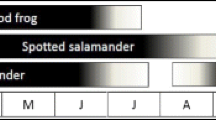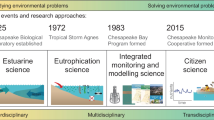Abstract
Use of citizen-scientists to collect data on natural resources is gaining credibility globally and is now considered a valuable tool in the conservation tool box. We conducted town-wide vernal pool inventories using citizen-scientists in four New England towns (USA) using voluntary best development practices (BDPs) for vernal pools. We tested the efficacy of using citizen-scientists to collect field data on vernal pools using published BDP guidelines. Steps included pool mapping and inventory, training of citizen-scientists, vernal pool field assessments, and guiding town development of local conservation strategies using data provided by the project. Potential vernal pools were remotely identified and photointerpreted. Partnerships among the University of Maine, the towns, and non-governmental organizations were forged to implement the project in spring 2003. Local coordinators in each town recruited volunteer citizen-scientists to conduct ground assessments. Volunteer training sessions were held prior to and during the field season. Fifty-two citizen-scientists surveyed and assessed 262 vernal pools. Quality control tests in the field confirmed that citizen-scientist data on amphibian egg mass counts were not significantly different from data gathered by biologists. Each pool was given a conservation priority rating based on the BDP assessment. Data were entered into a Geographic Information System database and delivered to each town. All towns initiated conservation plans and are developing conservation mechanisms to protect pools recognized as having conservation priority. Town strategies ranged from amending existing ordinances to improve wetland protection to incorporation of vernal pool resources into larger biodiversity mapping and planning projects. These four case studies illustrate that vernal pool conservation initiatives can be developed in local communities using the skills of trained citizen-scientists to collect accurate data. Communities are then better able to incorporate pool conservation strategies into the local planning and regulatory processes.
Similar content being viewed by others
Literature Cited
Baldwin, R. F., A. J. K. Calhoun, and P. G. deMaynadier. 2006. Conservation planning for amphibian species with complex habitat requirements: a case study using movements and habitat selection of the wood frog Rana sylvatica. Journal of Herpetology 40: 443–54.
Beginning with Habitat. 2003. http://www.beginningwithhabitat. org/index.html.
Berkes, F. 2004. Rethinking community-based conservation. Conservation Biology 18: 621–30.
Burne, M. R. 2001. Massachusetts Aerial Photo Survey of Potential Vernal Pools. Natural Heritage and Endangered Species Program, Department of Fisheries and Wildlife. Westborough, MA, USA.
Burne, M. R. and R. G. Lathrop. Remote and field identification of vernal pools. In A. J. K. Calhoun and P. deMaynadier (eds.) Science and Conservation of Vernal Pools in Northeastern North America. CRC Press, Boca Raton, FL, USA, in press.
Brody, S. D., V. Carrasco, and W. Highfield. 2003. Evaluating ecosystem management capabilities at the local level in Florida: Identifying policy gaps using geographic information systems. Environmental Management 32: 661–81.
Byron, I. and A. Curtis. 2002. Maintaining volunteer commitment to local watershed initiatives. Environmental Management 30: 59–67.
Calhoun, A. J. K. and P. deMaynadier. 2004. Forestry habitat management guidelines for vernal pool wildlife in Maine. Maine Department of Inland Fisheries and Wildlife. Wildlife Conservation Society Technical Paper #6, Rye, NY, USA.
Calhoun, A. J. K. and M. W. Klemens. 2002. Best development practices: Conserving pool-breeding amphibians in residential and commercial developments in the northeastern United States. MCA Technical Paper No. 5, Metropolitan Conservation Alliance, Wildlife Conservation Society, Bronx, New York, NY, USA.
Calhoun, A. J. K., N. A. Miller, and M. W. Klemens. 2005. Conserving pool-breeding amphibians in human-dominated landscapes through local implementation of Best Development Practices. Wetlands Ecology and Management 13: 291–304.
Calhoun, A. J. K., T. E. Walls, M. McCollough, and S. Stockwell. 2003. Developing conservation strategies for vernal pools: a Maine case study. Wetlands 23: 70–81.
Calhoun, A. J. K. and P. Reilly. Conserving vernal pool habitat through community based conservation. In A. J. K. Calhoun and P. deMaynadier (eds.) Science and Conservation of Vernal Pools in Northeastern North America. CRC Press, Boca Raton, FL, USA, in press.
Colburn, E. A. 2004. Vernal Pools: Natural History and Conservation. McDonald and Woodward Publishing Company, Blacksburg, VA, USA.
Colburn, E. A., S. Weeks, and S. Reed. Diversity and ecology of vernal pool invertebrates. In A. J. K. Calhoun and P. deMaynadier (eds.) Science and Conservation of Vernal Pools in Northeastern North America. CRC Press, Boca Raton, FL, USA, in press.
Cort, C. A. 1996. A survey of the use of natural heritage data in local land-use planning. Conservation Biology 10: 632–37.
Cushman, S. A. 2006. Effects of habitat loss and fragmentation on amphibians: a review and prospectus. Biological Conservation 128: 231–40.
Downing, D. M., C. Winer, and L. D. Wood. 2003. Navigating through the Clean Water Act jurisdiction: a legal review. Wetlands 23: 475–93.
Engel, S. R. and J. R. Voshell Jr. 2002. Volunteer biological monitoring: Can it accurately assess the ecological condition of streams? American Entomologist 48: 164–77.
Fore, L. S., Paulsen, K., and K. O’Laughlin. 2001. Assessing the performance of volunteers in monitoring streams. Freshwater Biology 46: 109–23.
Grant, E. H. C. 2005. Correlates of vernal pool occurrence in the Massachusetts, USA landscape. Wetlands 25: 480–87.
Harvey, E., D. Fletcher, and M. Shortis. 2001. A comparison of the precision and accuracy of estimates of reef-fish lengths determined visually by divers with estimates produced by a stereo-video system. Fishery Bulletin 99: 63–71.
Joly, P., C. Morand, and A. Cohas. 2003. Habitat fragmentation and amphibian conservation: building a tool for assessing landscape matrix connectivity. Comptes Rendus Biologies 326: S132-S139.
Klemens, M. W. and E. A. Johnson. 2005. Creating a framework for change. p. 349–62. In Johnson, E. A. and M. W. Klemens (eds.) Nature in Fragments: The Legacy of Sprawl. Columbia University Press, New York, NY, USA.
Lathrop, R. G., P. Montesano, J. Tesauro, and B. Zarate. 2005. Statewide mapping and assessment of vernal pool: A New Jersey case study. Journal of Environmental Management 76: 230–38.
Leibowitz, S. G. 2003. Isolated wetlands and their functions: an ecological perspective. Wetlands 23: 517–31.
Ludwig, D. 2001. The age of management is over. Ecosystems 4: 758–64.
Mahaney, W. and M. W. Klemens. Vernal pool conservation policy: the federal, state, provincial, and local context. In A. J. K. Calhoun and P. G. deMaynadier (eds.) Science and Conservation of Vernal Pools in Northeastern North America. CRC Press, Boca Raton, FL, USA, in press.
Moore, E. A. and T. M. Koontz. 2003. A typology of collaborative watershed groups: citizen-based, agency-based, and mixed partnerships. Society and Natural Resources 16: 451–60.
Preisser, E. L., J. Y. Kefer, J. D. Lawrence, and T. W. Clark. 2000. Vernal pool conservation in Connecticut: Assessment and recommendations. Environmental Management 26: 503–13.
Pope, S. E., L. Fahrig, and H. Gray Merriam. 2000. Landscape complementation and metapopulation effects on leopard frog populations. Ecology 81: 2498–2508.
Regosin, J. V., B. S. Windmiller, and J. M. Reed. 2003. Terrestrial habitat use and winter densities of the wood frog (Rana sylvatica). Journal of Herpetology 37: 390–94.
Rockwood, P. 1995. Landscape planning for biodiversity. Landscape and Urban Planning 31: 379–385.
Savan, B. and D. Sider. 2003. Contrasting approaches to community-based research and a case study of community sustainability in Toronto, Canada. Local Environment 8: 303–16.
Semlitsch, R. D. 2002. Critical elements for biologically-based recovery plans for aquatic-breeding amphibians. Conservation Biology 16: 619–29.
Semlitsch, R. D. and J. R. Bodie. 2003. Biological criteria for buffer zones around wetlands and riparian habitats for amphibians and reptiles. Conservation Biology 17: 1219–28.
Smith, M. A. and D. M. Green. 2005. Dispersal and the metapopulation paradigm in amphibian ecology and conservation: are all amphibians metapopulations? Ecography 28: 110–28.
Snodgrass, J. W., M. J. Komoroski, A. L. Bryan Jr, and J. Burger. 2000. Relationships among isolated wetland size, hydroperiod, and amphibian species richness: Implications for wetland regulations. Conservation Biology 14: 414–19.
Tappan, A. and M. Marchand. 2004. Identification and Documentation of vernal pools in New Hampshire (second edition). New Hampshire Fish and Game Department, Nongame and Endangered Wildlife Program. Concord, NH, USA.
Theobald, D. M., R. J. Hobbs, T. Bearly, J. A. Zack, T. Shenk, and W. E. Riebsame. 2000. Incorporating biological information in local land-use decision-making: designing a system for conservation planning. Landscape Ecology 15: 35–45.
Vasseur, L. L. LaFrance, D. Renaud, D. Morin, and T. Audet. 1997. Advisory committee: a powerful tool for helping decision makers in environmental issues. Environmental Management 21: 359–65.
Wilson, A. J., L. Uncapher, L. McManigal, L. Hunter Lovins, M. Cureton, and W. D. Browning. 1997. Green Development: Integrating Ecology and Real Estate. John Wiley and Sons, Inc., Hoboken, NJ, USA.
Author information
Authors and Affiliations
Corresponding author
Rights and permissions
About this article
Cite this article
Oscarson, D.B., Calhoun, A.J.K. Developing vernal pool conservation plans at the local level using citizen-scientists. Wetlands 27, 80–95 (2007). https://doi.org/10.1672/0277-5212(2007)27[80:DVPCPA]2.0.CO;2
Received:
Revised:
Accepted:
Issue Date:
DOI: https://doi.org/10.1672/0277-5212(2007)27[80:DVPCPA]2.0.CO;2




